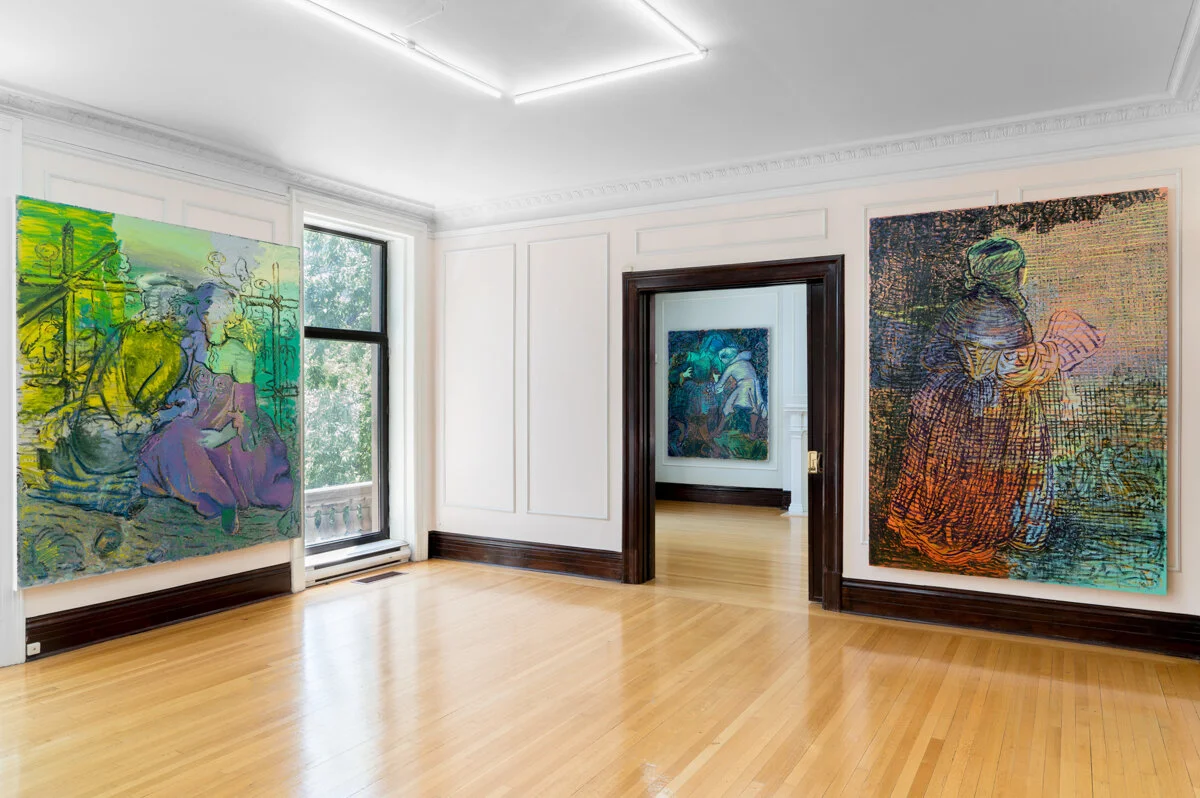Beguiling Tedious Hours
Artists: Delphine Hennelly (Brooklyn-Montreal)
Exhibition: June 10 – July 17, 2021
"Beguiling Tedious Hours with Romances and Fairy Tales and Fool’s Paradises"
– George Bernard Shaw
The Temptations:
5 Thoughts on Delphine Hennelly
1. Take everything in. Ravenously. The figures and the fleshy bodies and fabrics that they come in. Glowing rectangles from another time. And inside those rectangles also secret codes and stories, written in objects and faintly handwritten words. Ingest the weirdly soft-hard, pigmented-oil images, so that they and their contents become yours too. So that they become one with your bones, fat, flesh, fantasy. In a way that lets you, or makes you, work.
2. This ravenous taking in and working is what I remember from Delphine’s New Jersey studio, which I visited several years ago. I was envious of the energy in that room. Although she hadn’t been there long, the big paintings were already stacked deep against the walls. They contained people, specifically nymphs and fairies. And flowers. All of which were also clouds and blotches of screaming colour, pulled into form — into fiction, into fantasy visions — by swooping and jotted outlines. In the middle of the room there was a metal cart, filled with paint tubes and brushes. The scene’s romance lurched and pulled against the unmistakable presence of nearly constant work.
3. It is a wellspring of painted images, the history of a particular stream of painting, that Delphine was, and still is, devouring and re-digesting. Irrespective of the narrative and symbolic content of the pictures, I was on that first visit floored by the intensity of their engagement. The work’s volume and formal zest reflected an artistic process made of desire bordering on basic need, like imagination and reality crashing against one another on a wild shore. As is typically the case with intense needs, this one — Delphine’s relentless in-taking and re-working of painting — communicates anxiety. To need something this badly is to know that the thing you need may at some point run dry. And so you keep going as fast as you can. Flipping through books of paintings and mental files of the same. Taking in as much while you can. Pages turning. Traces of chunky paint blooming delicious oil stains on the paper, spilling uncanny chimaeras of form and body into the canvas.
4. But none of this means anything without technique. What Delphine does, through her painting method, is translate historical languages of picture making, into a vibe; no longer a language, but so much as a force field. In counterpoint to the historical work which she draws upon (Cranach when we last spoke...), which is characterized by a tension of hyper-smooth verisimilitude and hypnogogic bizarreness, Delphine’s pictures are suspended in a state of falling apart. Almost vanitas-esque, like a wildly gorgeous neon rotting. Except that what is here rotting, at once dying and living, is not fruit and flesh, but their equivalent in the nourishing form of painting itself.
5. The work’s historical inspiration can be detected in the presence of human beings, dressed in the clothing of another time, and motifs echoing the themes of another time in art, like mothers caring for children: Cranach’s Venus and Cupid, Michelangelo’s Pieta. But here, the pained smoothness of those historical feeders has decomposed — pictorially and biologically — into loose assemblies of painterly qualities (blotches, patches, fields, streaks, lines...) which instead of fooling the human eye, render an unending state of unfinished-ness. An unfinished, un-closed, and therefore actual relationship. To painting, yeah. But by way of painting, to pleasure in its intoxicating and terrifying complexity.
Text by Mitch Speed
_______________________________________________
Biography
Delphine Hennelly (Montreal, Canada) received her BFA from Cooper Union in 2002 and her MFA from Mason Gross School of the Visual Arts at Rutgers University in New Jersey in 2017. A painter, drawer and occasional printmaker, Hennelly explores figuration primarily using the female form. She is a three-time recipient of The Elizabeth Greenshields Foundation Award. Recent exhibitions include a solo at Pt.2 Gallery (Oakland, USA) as well as a group show organized by James English Leary at Lisa Kandlhofer Gallery (Vienna, Austria) and a two-person show with Mimi Jung at Carvalho Park (New York, USA).









